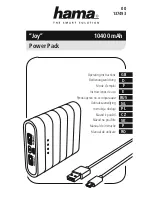
V. Short circuit
Danger
Danger
During operation, never short the positive and negative poles of the DC distribution unit of the
pow er system or the non-grounding pole and the earth. The pow er system is a constant-voltage
DC pow er device, short circuit w ill result in equipment burning and endanger human safety.
Check the polarity of the cable and connection terminal when performing DC live operations.
As the operation space in the DC distribution unit is very tight, please carefully select the operation space.
Never wear a watch, bracelet, bangle, ring, or other conductive objects during operation.
Use insulated tools.
In live operation, keep the arm , wrist and hand tense, so that when the tool in operation slips , the movement of
the human body and tool is reduced to a minimum.
Battery
Danger
Danger
Before any operation on battery, read carefully the safety precautions for battery transportation and
the correct battery connection method.
Note
If the pow er system does not connect w ith mains pow er for a long time, to prevent battery
over-discharge, users should cut batteries off from the pow er system thoroughly, for example, pulling
out battery fuses or sw itching off battery MCBs. Before putting the pow er system into operation, insert
all the battery fuses or sw itch on all the battery MCBs.
Non-standard operation on the battery will cause danger. In operation, precautions should be taken to prevent
battery short circuit and overflow of electrolyte. The overflow of electrolyte will erode the metal objects and PCBs,
thus causing equipment damage and short circuit of PCBs.
Before any operation on battery, pay attention to the following points:
1. Remove the watch, bracelet, bangle, ring, and other metal objects on the wrist.
2. Use specialized insulated tools.
3. Use eye protection device, and take preventive measures.
4. Wear rubber gloves and apron to guard against electrolyte overflow.
5. In battery transportation, the electrode of the battery should always be kept facing upward. Never put the
battery upside down or slanted.
LLVD And BLVD
The power system has battery low voltage disconnection (BLVD) function and load low voltage disconnection
(LLVD) function. LLVD means that the mains fail and batteries supply power, the controller cuts the non-priority
load off when the battery voltage drops down to below 44V. In this way, the battery remaining capacity can
sustain the priority load longer. BLVD means that the controller cuts the load off when the battery voltage drops
down to 43.2V to prevent over-discharge.
The factory setting is enabling LLVD and BLVD, which means th at if power outage lasts for a long time or the
power system fails, there might be LLVD and BLVD. Users should classify the loads and connect the non -
priority loads to LLVD routes, and connect the priority loads to BLVD routes. For vital loads, users can disable
BLVD of these loads to insure reliability of the power supply.
The method of disabling BLVD is:
1. Hardware disabling: unplug the signal cable in J10 interface of the controller. Tag the BLVD -disabled label.
The position of the controller and the interface description are given in 2.4.2 Connecting Signal Cables.
2. Software disabling: set
‘BLVD Enable’ item of the controller to ‘N’.




































